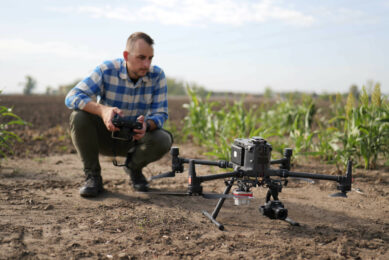Researchers study herbicide spray applications using drones

To bring drone spray technology to farmers’ fields, Virginia Tech researchers in the USA are looking to standardize unmanned aerial systems (UAS) for herbicide spray applications.
The project, led by Vijay Singh, an assistant professor in the College of Agriculture and Life Sciences and Virginia Cooperative Extension specialist at the Eastern Shore Agricultural Research and Extension Center, stemmed from Singh’s previous research efforts on UAS spray research few years ago, which was a first for the mid-Atlantic region.
Producers spend between $6 billion to $8 billion annually in the U.S. on herbicide usage. Repeated use of the same herbicides over the years has resulted in the evolution of herbicide resistance.
Increased costs
Additional practices and strategies to deal with herbicide-resistant species have led to increased costs of $50 to $100 per acre. General crop production cost and use of labor in specialty crops, such as watermelon, have increased in recent years, which acts as a barrier to achieving higher returns. Researchers have observed that increasing spray efficiency, timely application, and site-specific operations can effectively control weeds and reduce herbicide-usage significantly.
“Until recently, the use of UAS for weed management was limited to mapping and classification only,” Singh said. “However, UAS-based herbicide applications have opened new opportunities to control weeds in areas inaccessible by tractors, in wet fields, and to manage late-season weed escapes.”
The two grants totaling approximately $1 million from the National Institutes of Food and Agriculture will not only focus on research objectives but through these projects, UAS technologies will be demonstrated at producers’ fields, and they will be provided firsthand experience. The project team will evaluate different spray volumes, droplet sizes, altitude, spray speed, and large-scale spray operations.
Preemergence and postemergence herbicides
The Agriculture and Food Research Initiative grant will evaluate the efficiency of blanket applications of both preemergence and postemergence herbicides in row crops. The Crop Protection and Pest Management Program grant will focus on watermelon and other vine crops. Spot-spray operation process will be streamlined, and precision and efficiency will be evaluated and both projects involve economic assessment of the proposed technologies.
“The testing of UAS is the first step but the overall goal of these technologies is to automate the process and conduct real-time weed detection and spray applications, which we will achieve in the next few years,” Singh said.
Previously, the team has worked with LeadingEdge Aerial Technologies and Homeland Surveillance & Electronics LLC for conducting preliminary studies. With the project’s expanded scope, additional drones and UAS industry partners will be included.
Join 17,000+ subscribers
Subscribe to our newsletter to stay updated about all the need-to-know content in the agricultural sector, two times a week.



